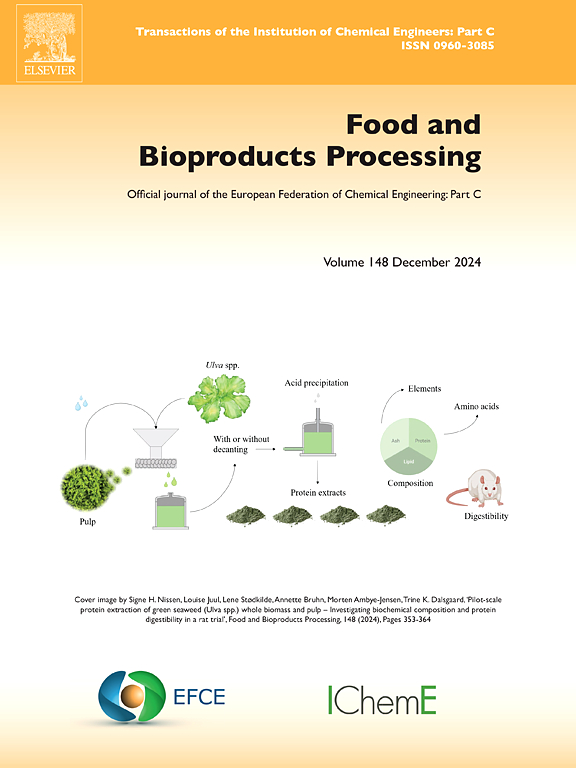Extraction of protein from Alphitobius diaperinus larvae (lesser mealworm) powder using tailored bio-based ionic liquids
IF 3.5
2区 农林科学
Q2 BIOTECHNOLOGY & APPLIED MICROBIOLOGY
引用次数: 0
Abstract
The present investigation aims to optimize a protein extraction process from Alphitobius diaperinus (lesser mealworm) larvae using designer ionic liquids. Three ionic liquids were synthesized using choline esters of C8, C10, and C12 chains, with potassium lactate as the anion. Their purity was confirmed via NMR spectroscopy and elemental analysis, indicating their suitability for extracting protein from lesser mealworm insect powder. All analyses were performed in triplicate and the results were evaluated by an ANOVA, extraction was initially performed by mechanical shaking followed by ultrasound. The results revealed protein extraction yields ranging from 46.4 % ± 1.7–64.7 % ± 2.1, with a protein content between 53.3 % ± 1.8 and 63.3 % ± 2.4, as verified by FTIR analysis. In particular, FTIR spectra exhibited consistent signals across samples, with absorption peaks at 1600–1700 cm−1 assigned to the amide I band and peaks at 1500–1600 cm−1 attributed to the N-H in the amide II band. Further investigations were conducted to assess ± the influence of particle size on the extraction process, revealing that a particle size of 300 µm yielded the best extraction results. Importantly, analysis via 1H NMR demonstrated that the structure of the ionic liquid remained unchanged throughout the extraction process, validating its potential for reuse in subsequent extractions. Despite the good results obtained in the extractions, there is still much work to be done. Future research must focus on improving extraction yields and the purity of the precipitates by optimising operating conditions such as time, temperatures, and ratios.
利用特制生物基离子液体从小粉虫幼虫粉末中提取蛋白质
本研究旨在优化设计离子液体从小粉虫幼虫中提取蛋白质的工艺。以乳酸钾为阴离子,以C8、C10和C12链胆碱酯为原料合成了三种离子液体。经核磁共振波谱和元素分析证实其纯度,表明其适用于小粉虫粉中蛋白质的提取。所有分析一式三份,并通过方差分析对结果进行评估,提取最初是通过机械震动进行的,然后是超声波。结果显示蛋白质提取收益率从46.4 % ±1.7 - -64.7 % ±2.1 ,蛋白质含量之间53.3 % ± % 1.8和63.3±2.4 ,作为验证了红外光谱分析。特别是,不同样品的FTIR光谱显示出一致的信号,1600-1700 cm−1的吸收峰属于酰胺I波段,1500-1600 cm−1的吸收峰属于酰胺II波段的N-H。进一步研究了± 粒径对提取过程的影响,发现粒径为300 µm时提取效果最佳。重要的是,通过1H NMR分析表明,离子液体的结构在整个提取过程中保持不变,验证了其在后续提取中重复使用的潜力。尽管在提取中获得了良好的结果,但仍有许多工作要做。未来的研究必须集中在通过优化操作条件(如时间、温度和比例)来提高萃取率和沉淀的纯度。
本文章由计算机程序翻译,如有差异,请以英文原文为准。
求助全文
约1分钟内获得全文
求助全文
来源期刊

Food and Bioproducts Processing
工程技术-工程:化工
CiteScore
9.70
自引率
4.30%
发文量
115
审稿时长
24 days
期刊介绍:
Official Journal of the European Federation of Chemical Engineering:
Part C
FBP aims to be the principal international journal for publication of high quality, original papers in the branches of engineering and science dedicated to the safe processing of biological products. It is the only journal to exploit the synergy between biotechnology, bioprocessing and food engineering.
Papers showing how research results can be used in engineering design, and accounts of experimental or theoretical research work bringing new perspectives to established principles, highlighting unsolved problems or indicating directions for future research, are particularly welcome. Contributions that deal with new developments in equipment or processes and that can be given quantitative expression are encouraged. The journal is especially interested in papers that extend the boundaries of food and bioproducts processing.
The journal has a strong emphasis on the interface between engineering and food or bioproducts. Papers that are not likely to be published are those:
• Primarily concerned with food formulation
• That use experimental design techniques to obtain response surfaces but gain little insight from them
• That are empirical and ignore established mechanistic models, e.g., empirical drying curves
• That are primarily concerned about sensory evaluation and colour
• Concern the extraction, encapsulation and/or antioxidant activity of a specific biological material without providing insight that could be applied to a similar but different material,
• Containing only chemical analyses of biological materials.
 求助内容:
求助内容: 应助结果提醒方式:
应助结果提醒方式:


